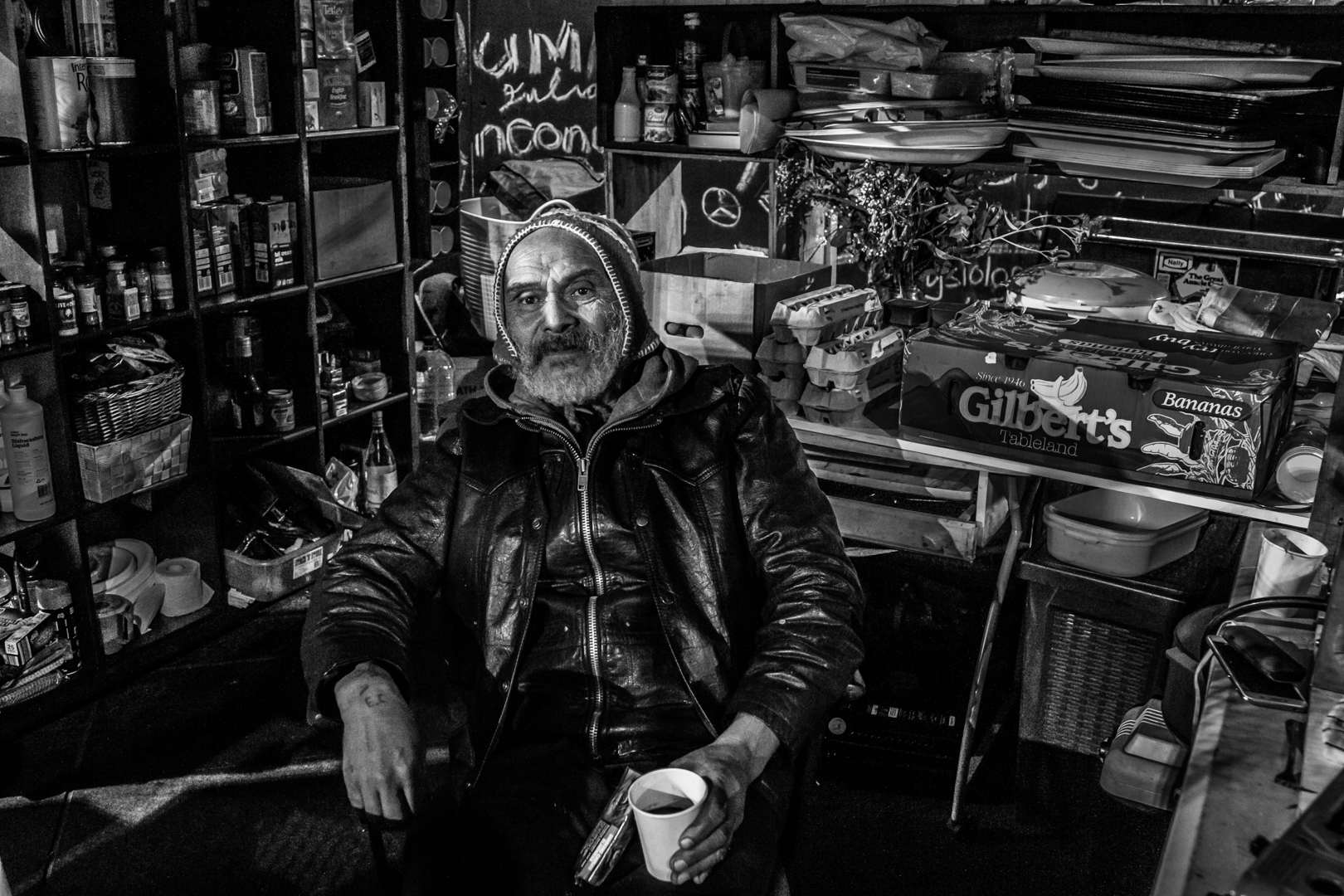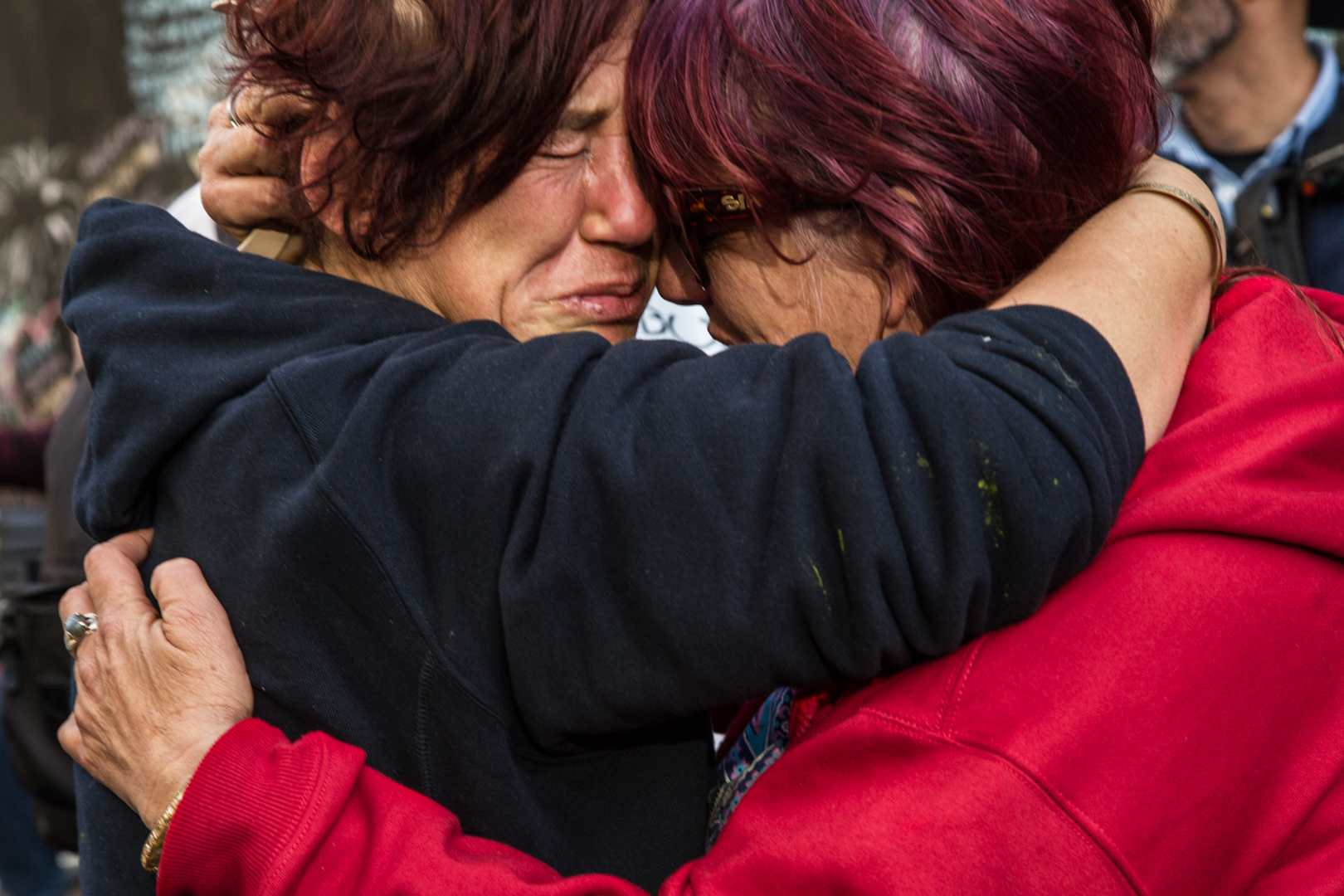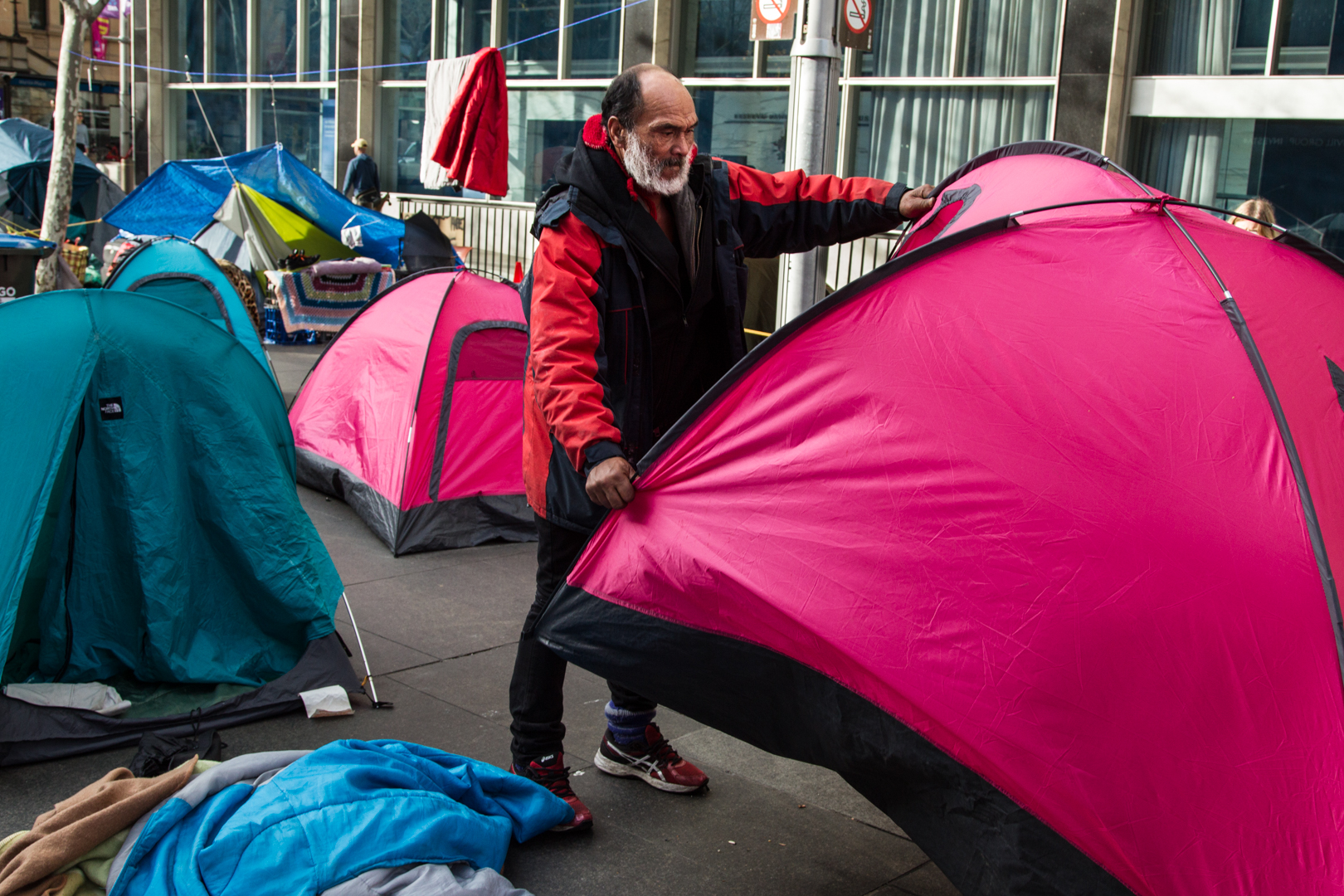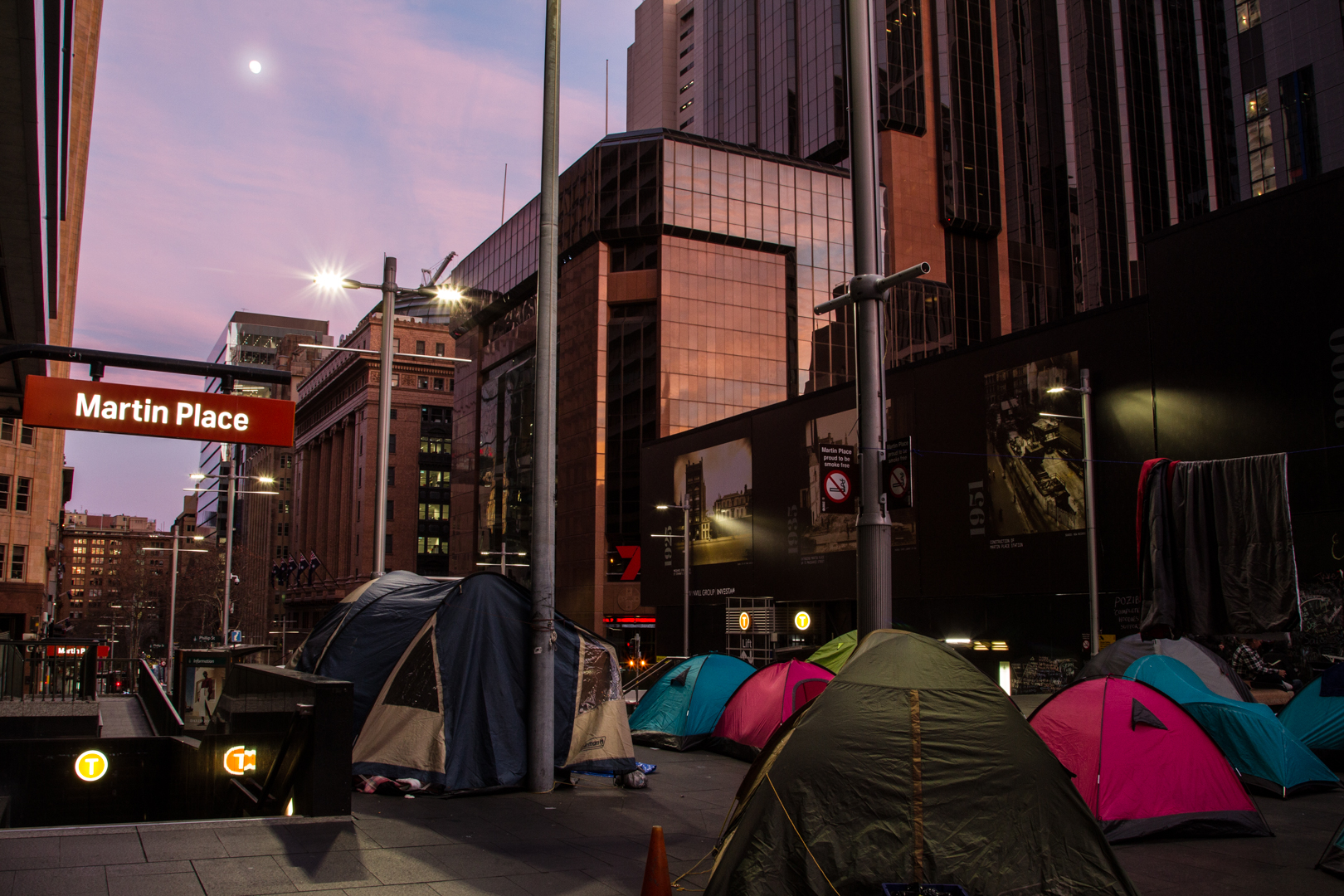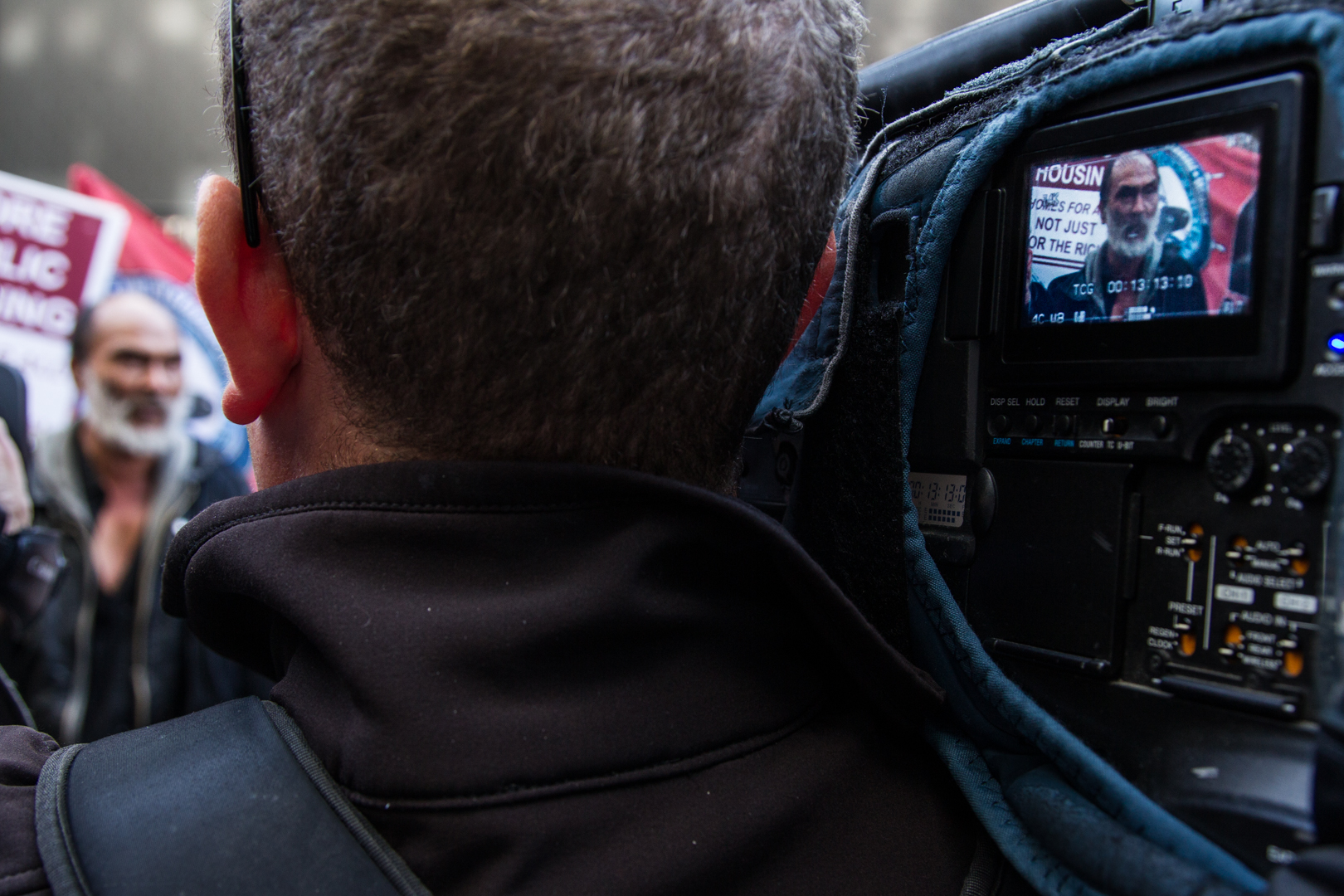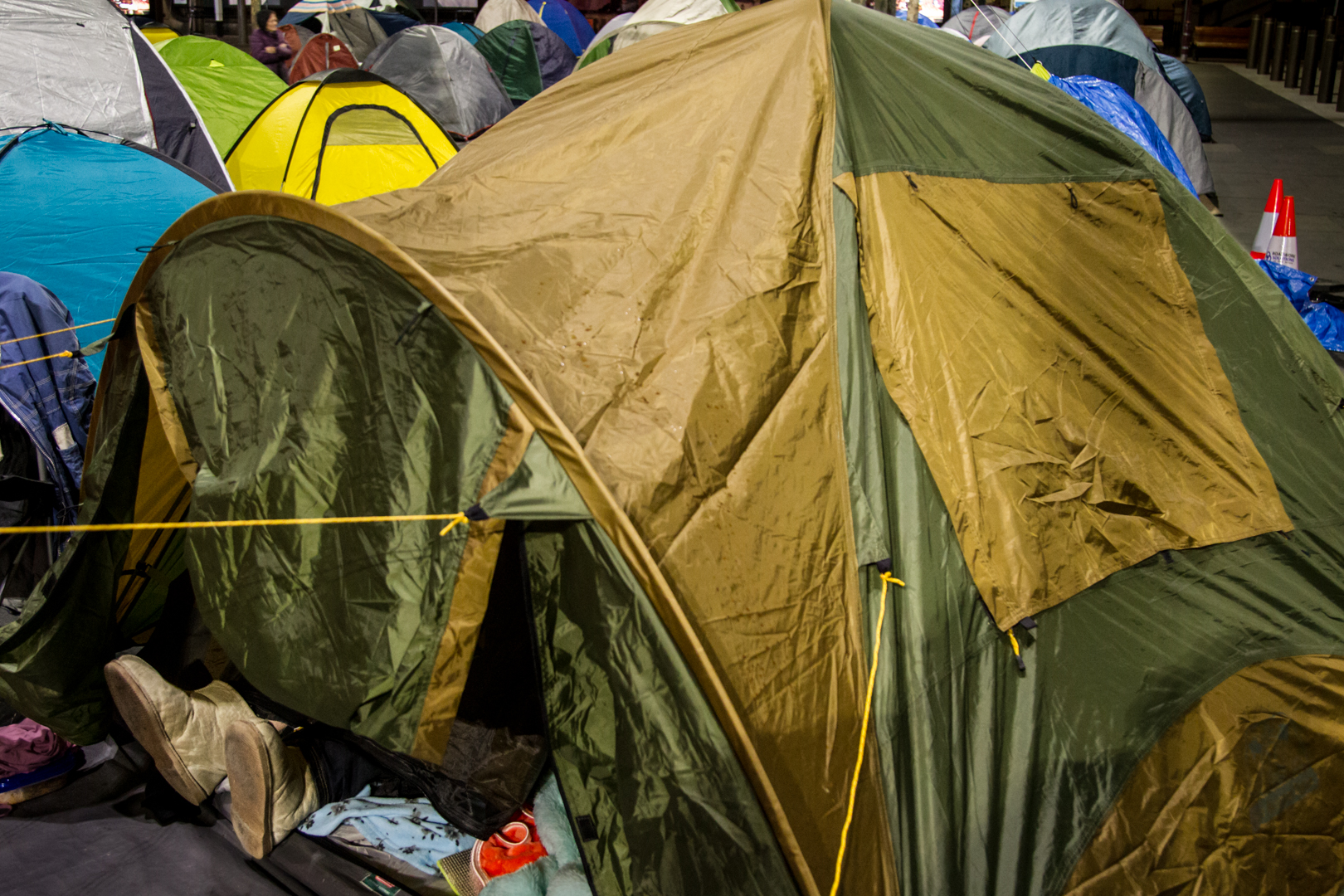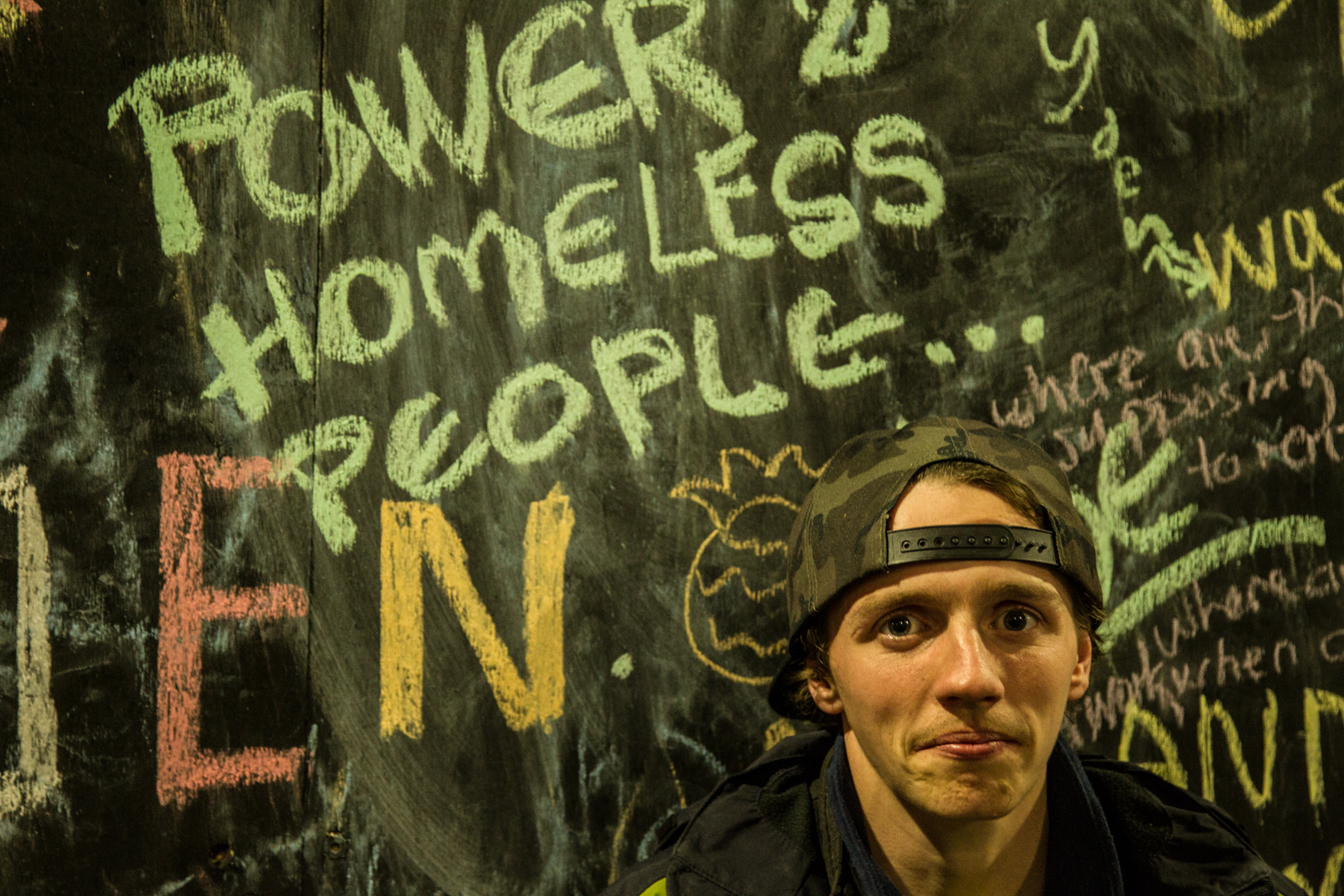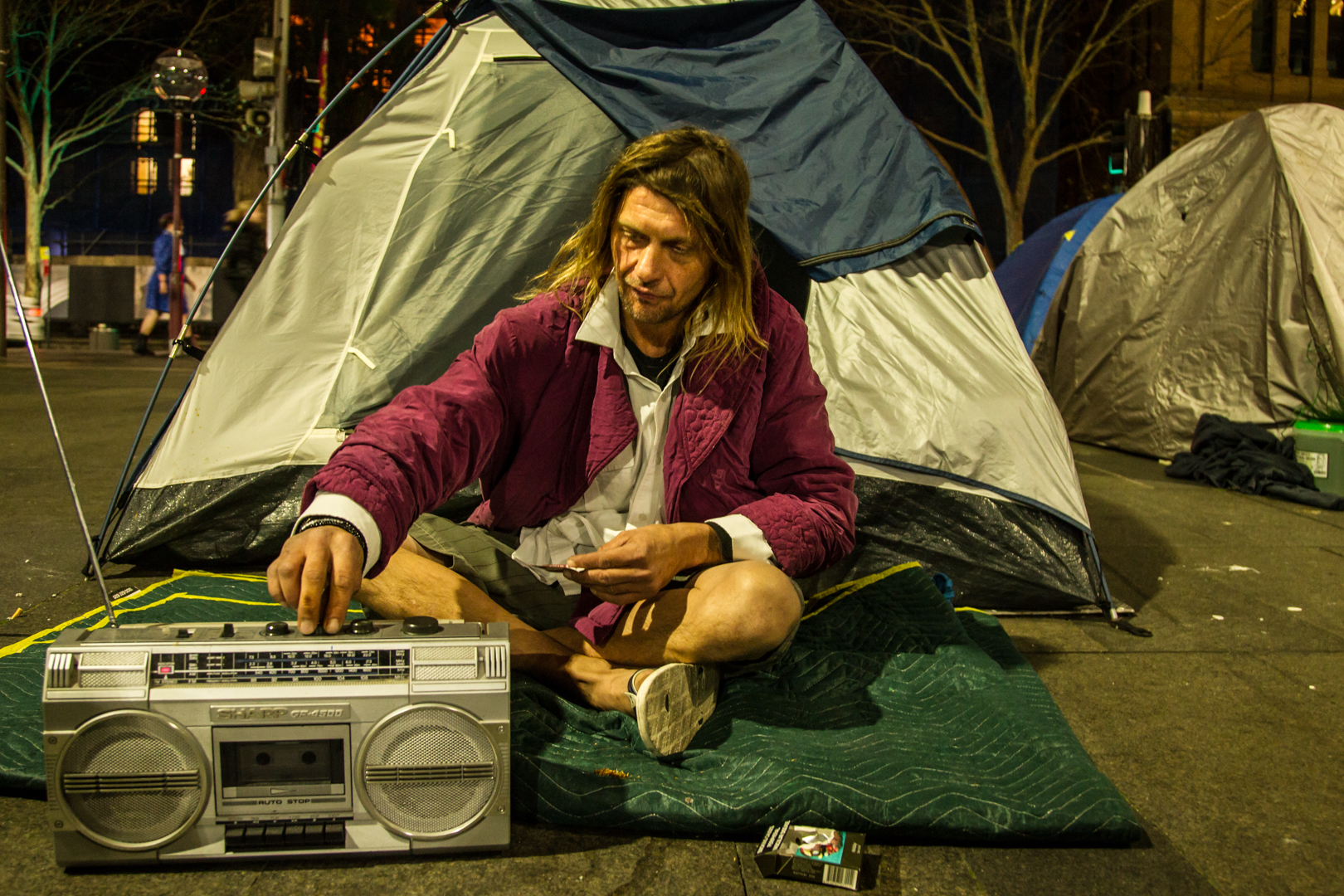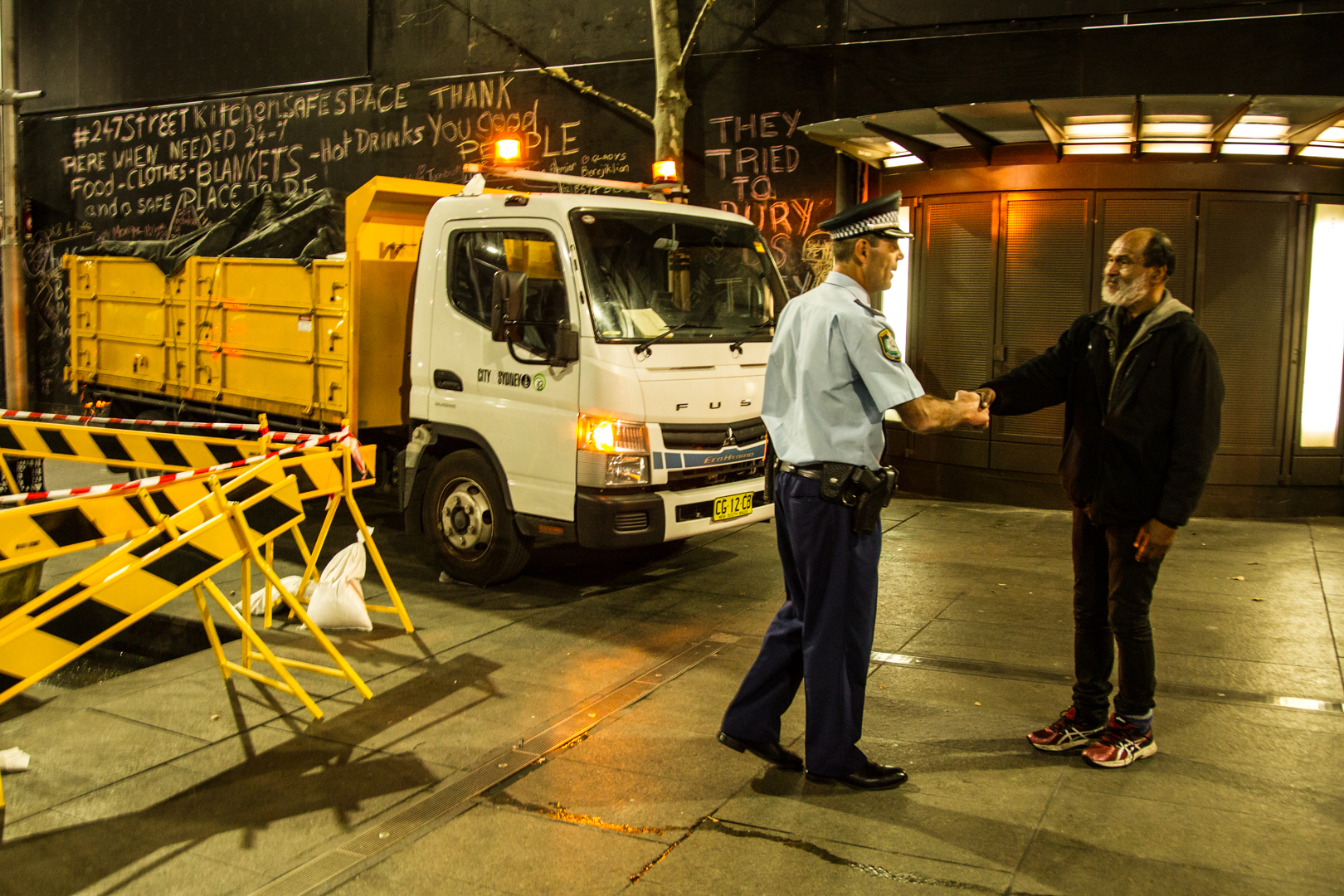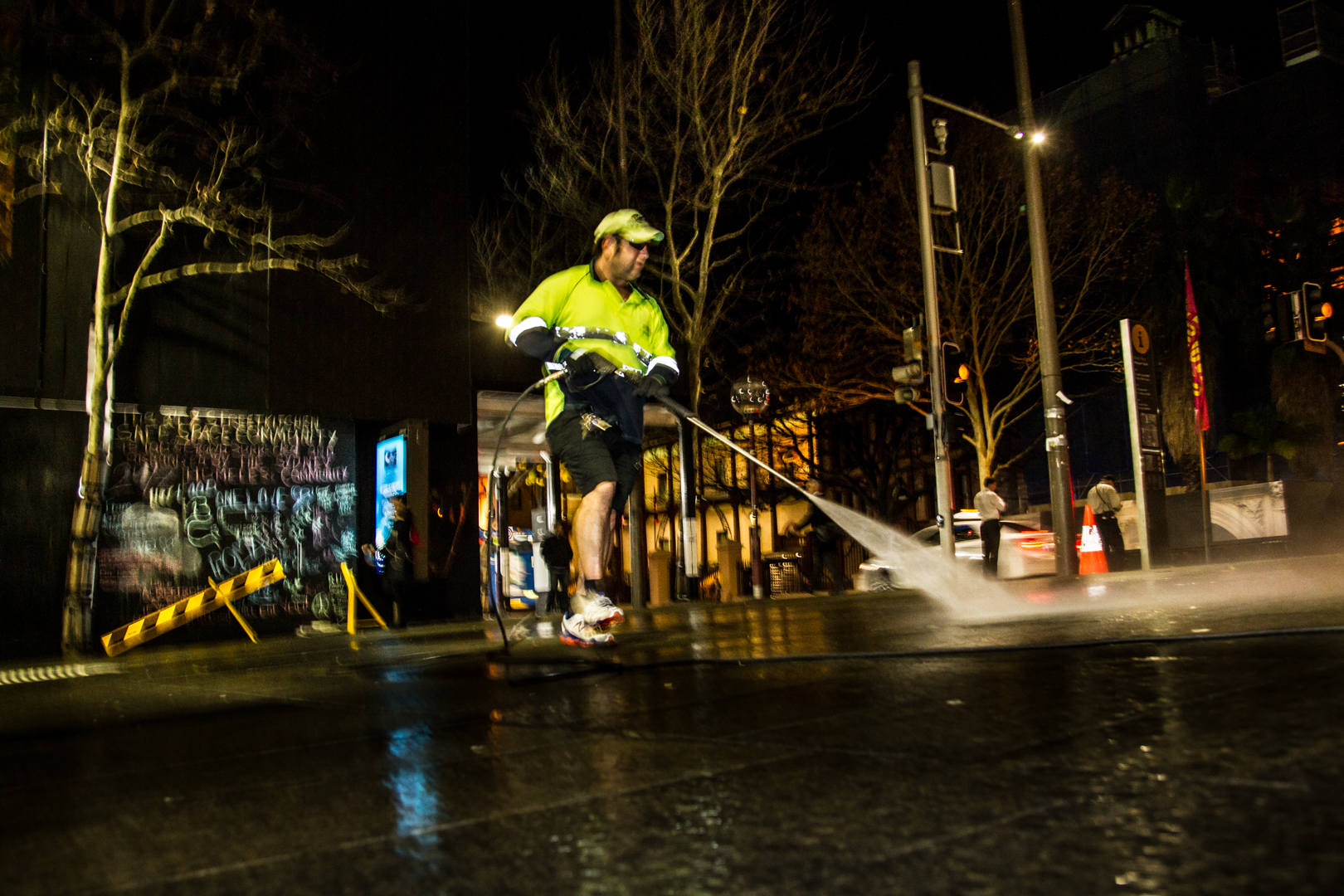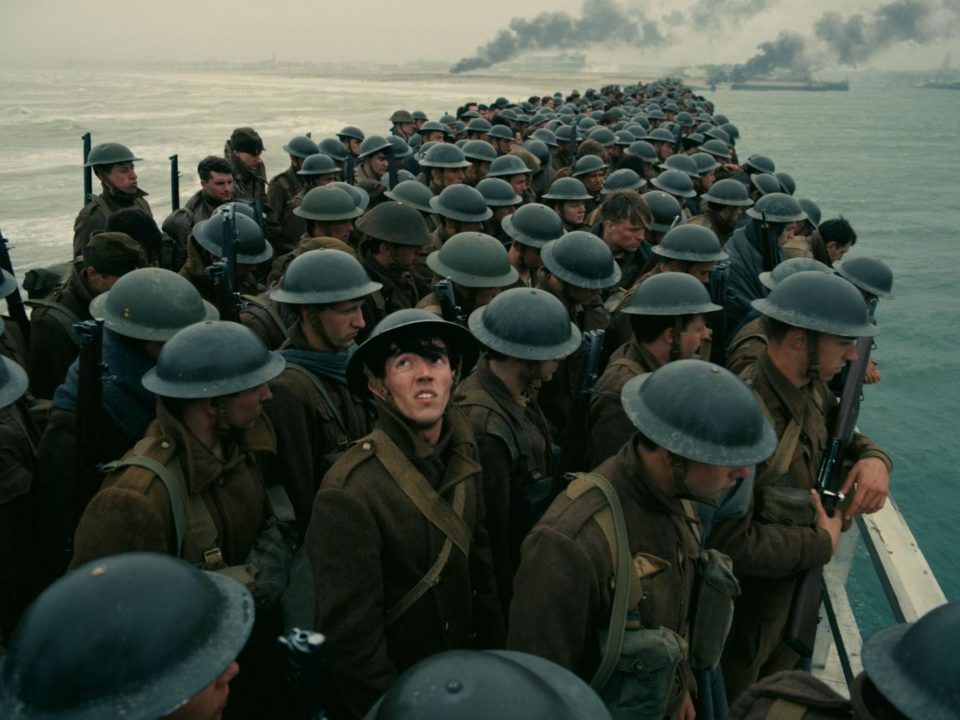It’s getting close to kick-out time. With only hours before the forced removal of the financial district’s homeless population is expected to begin, every second person surrounding ‘Tent City’ in Martin Place appears to be either a reporter or a charity worker.
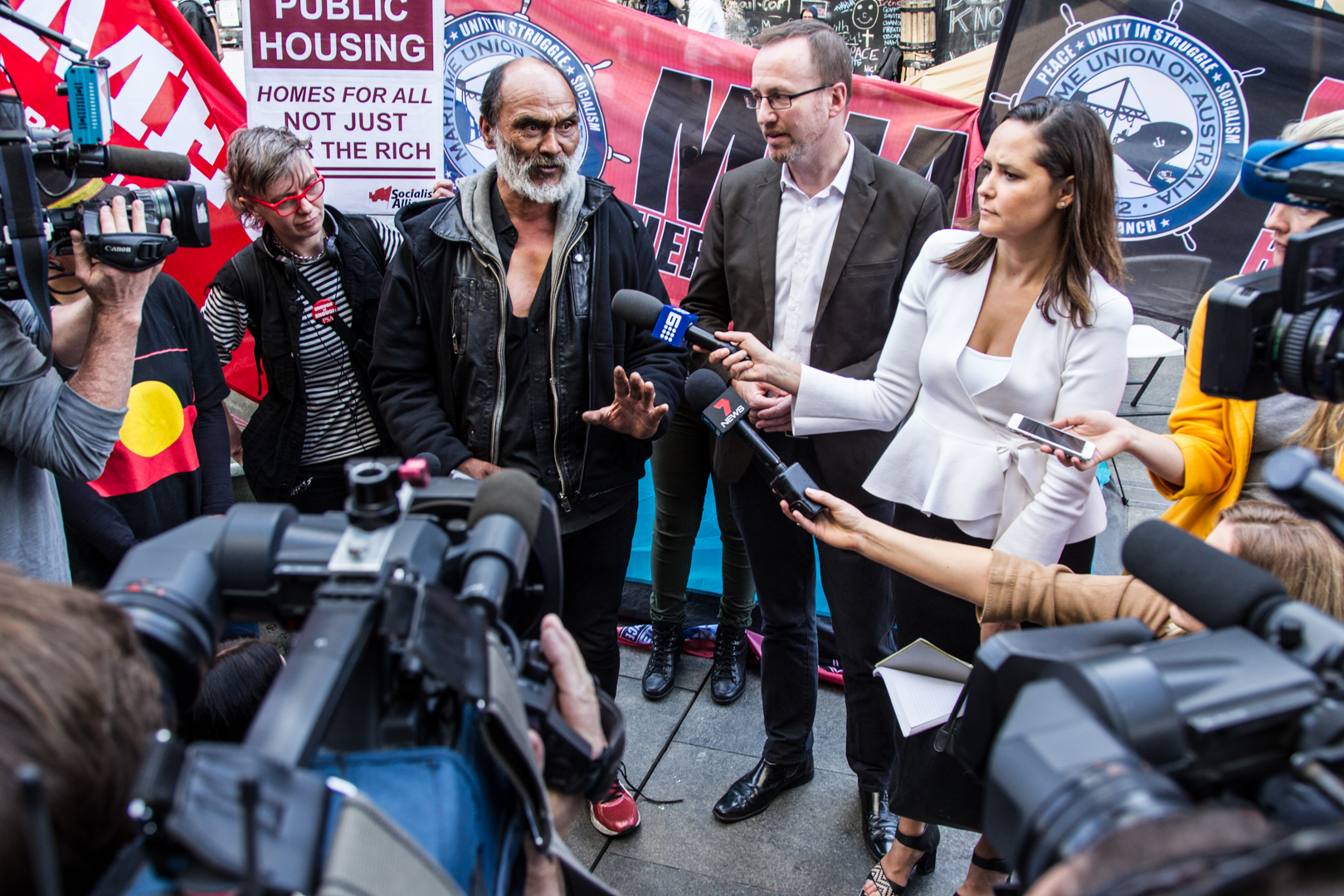
Tent City co-ordinator Lanz Priestley addresses the media with support from the Maritime Union of Australia (MUA), the construction division of the CFMEU, indigenous representation and Greens MP David Shoebridge. © Glenn Lockitch 2017
Not all are sticking around for the spectacle. Steven O’Lachlan and his friend Lawrence are waiting for the 11.23pm train from Martin Place to Kiama. Every night they take the longest, uninterrupted ride their Opal cards can afford as a means of temporary accommodation.
“We snake down the south coast and go to sleep if we can. You go with a friend just to stay safe because the Wollongong kids will steal your stuff sometimes. Then we come back.”
What do you take with you?
“Just a sleeping bag, blankets. Whatever you can get from the Vinnies truck. You don’t want to take too much because you don’t want to upset the general public as well.”
Tent City’s final night is pleasantly mild in contrast to the freezing wind tunnel that usually defines Martin Place when the sun drops during winter. I ask Steven what brings him and others back to this inhospitable part of the city.
“We know we can always get food here,” he says. “If you go out to Parramatta, you can still get food, but in places like Central it’s hit and miss … [So] it’s more convenience. We get the food and then we go home. Not ‘home’, but on the train. That way we’re not stuck here annoying people.”
Our conversation is interrupted several times by people offering packets of socks and underwear. A large dining table is being folded up and plates of chocolate and banana cake are passed around.
Lanz Priestley, the unofficial leader of the homeless group is sitting along a wall near Macquarie Street. On Friday morning the Berejiklian Government’s targeted legislation – granting police extra ‘move-on’ powers on Crown land within the City of Sydney – was given final assent and passed into law in order to deal with Tent City.
At the same time, a disturbing story about Priestley appeared in The Australian newspaper. The ‘Mayor of Martin Place’, as he’s been called, was depicted as an attention-seeking criminal with a violent past and an unreliably stated biography.
This much can be said. After Lanz Priestley’s experiences with Occupy Sydney in 2011, the sometimes builder and furniture removalist, who reputedly spends about half his time living on the streets, emerged as a highly vocal activist for homeless people in the city, scathing in his critiques of everybody from government policy makers to NGOs and charity organisations.
Priestley became the founder of the 24-7 Street Kitchen and Safe Space over six months ago. This was a co-op run by homeless people for homeless people, making use of public donations and gifts, at its peak serving up to 500 meals a day and finding people jobs and accommodation as well. It first took root under the hoardings of a building site opposite the Reserve Bank in the CBD. Food, clothing and safety at night were early motivators for people gathering around it and forming a community.
City of Sydney figures for February of this year listed 948 people homeless in the city centre: 433 of them sleeping rough and 489 making their way through temporary and crisis accommodation, with another 26 in hospital. Homelessness Australia put the state-wide figure for NSW at just over 29,000.
The 24-7 Street Kitchen and Safe Space evolved steadily into the Tent City homeless community protest. Priestley told the ABC in late June, “The City of Sydney really have no plan for homeless people in the CBD. They want us gone from Sydney because we’re an embarrassment.”
At the start of this week, National Homelessness Week, there were about 50 tents pitched in Martin Place, with around 100 people living in them. Arguments between NSW Premier Gladys Berejiklian and Sydney Lord Mayor Clover Moore over whether this was a Council or State issue to sort ended with the collapse of a supposed “truce” that Moore had negotiated with Priestley. It had involved the creation of what would be a temporary 24-hour “safe space” where the homeless camp could be moved before finding individuals more permanent accommodation.
Fears of a community being splintered – and criticism of accommodation offers that were long-term unaffordable and impractical – merged with darker views of Lanz Priestley, as a Machiavellian stirrer harnessing more genuinely homeless people to his own political ends.
Monday’s good news had soured into confusion by Tuesday and the camp stayed on at Martin Place. With public concern mounting and the likes of shock-jock Alan Jones buying into the debate, Gladys Berejiklian expressed a reluctant need for her State Government to act.
By placing the matter squarely back in the Premier’s hands, Moore had skillfully out-manouvered the State Government. The dispute between Moore and Berejiklian threatened to overshadow a now intensely visible public issue: what to do with the increasing numbers of homeless in our city?
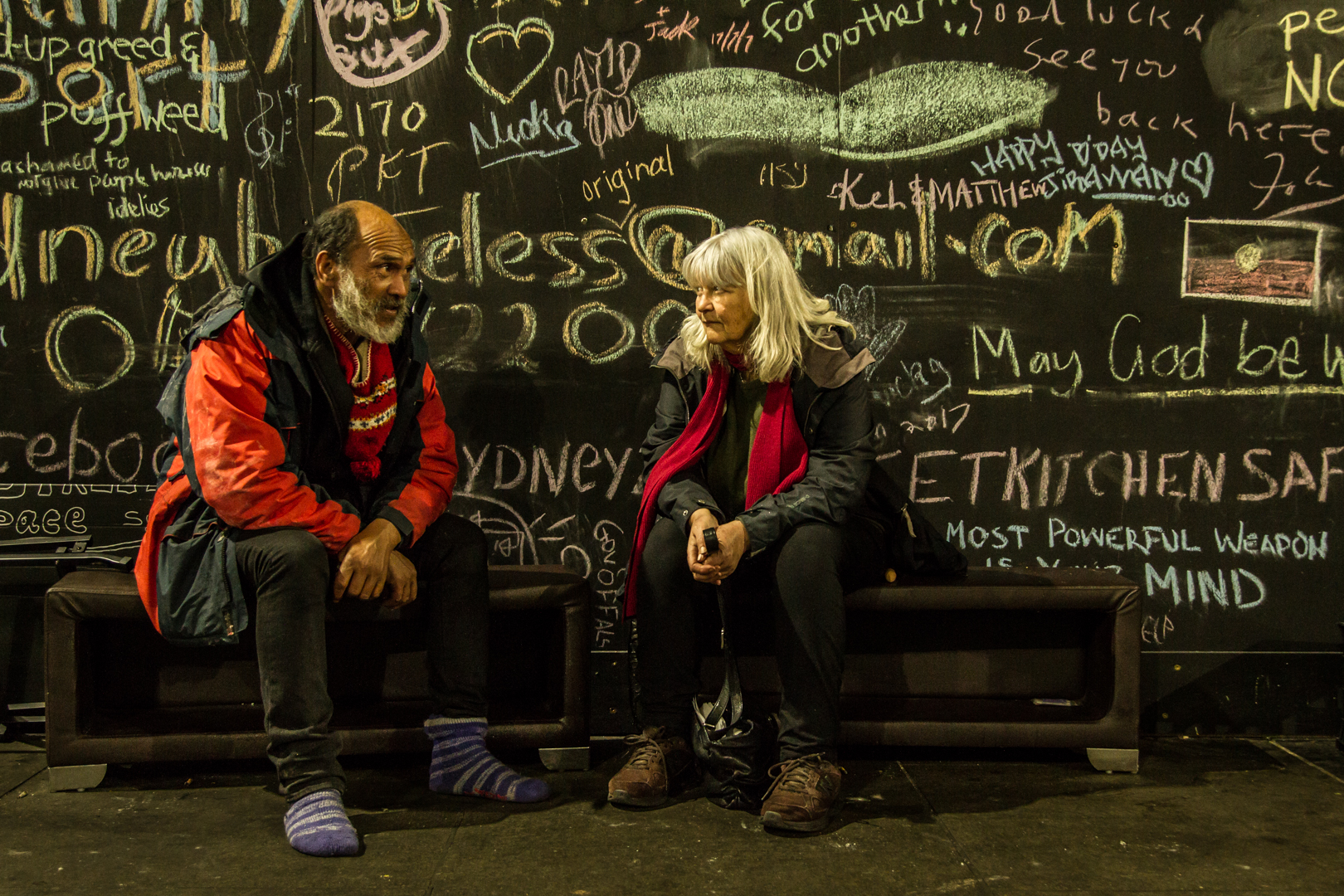
Homeless Tent City co-ordinator Lanz Priestley and investigative journalist, activist and academic Wendy Bacon discuss the looming threat by the New South Wales State Government politicians to use the police to move in on the homeless in Martin Place, Sydney. © Glenn Lockitch 2017
Entirely charming, articulate and welcoming, Lanz Priestley certainly has a talent for knowing exactly what to say. When I mention the burden of his elevated profile in the wake of The Australian’s report he tells me he’s happy for his time in the spotlight to pass. Priestley’s more worried about how the police intend to use their new ‘move on’ powers today.
“My main concern is for the safety of the guys in these tents. At the end of the day tents – infrastructure – come decidedly second to making sure every last person here is safe. It’s very possible they’ll use the riot squad here. I’ve done what I can to try and ensure that doesn’t happen. I don’t want the guys here if the police decide to bring the riot squad in.”
What will you do if that happens?
“If it happens, it happens. In preparation for it, we’ve set up a triage around the corner.”
Have any politicians bothered to visit?
“Clover’s been here a couple of times in recent times. She wouldn’t come near us until it was politically expedient to do so. And to be fair, y’know, Clover’s one of the most astute sniffers-of-the-wind in Australia.”
As we speak, a middle-aged woman who is obviously a Tent City resident sits at the communal piano and, for the next 40 minutes, plays Auld Lang Syne in a continuous loop. Lanz has been in camp since December 17, and is resigned to the likelihood Tent City will be removed within hours. I ask him why the group made their stand in Martin Place.
“Within 400 metres of here every living Australian Prime Minister has an office. Also, within 400 metres, most of the decision-makers who caused this, have their offices. The way I see it, it would be remiss of us not to let them see the results of their work.”
The results of “their work” becomes apparent at 8.30am.
After a sleepless night, Priestley calls Tent City residents together.
“We’re pulling out,” he announces, “and if you don’t understand why, read Sun Tzu, The Art of War.”
From morning to lunchtime, belongings are bundled up into black rubbish bags. A scrapheap of disassembled tents builds between Macquarie and Castlereagh Streets.
Speaking to the ABC, Priestley reflected on what the homeless vigil has achieved.
“Well I think there’s a clear conversation out there now, that government and NGOs who have been telling the public that they’ve got this – I think it’s in the public eye now – that they clearly haven’t got it.
“All the decision-makers can see this. They’re not seeing the people camped up in the Hawkesbury. They’re not seeing the people who are out of homes all over the state.”
By dusk, Tent City has disappeared. Clearly exhausted, Priestley is loading gear onto a City of Sydney truck whilst fuming about a lost hot water urn. Earlier in the day, he was informed 350 police officers were waiting on standby, should there be any trouble.
“It’s the only fucking thing that could be damaged. And it’s on a different truck. It cost us $800!”
Ex-residents sweep the tiled surfaces they’ve been sleeping on, picking up cigarette butts stuck between cracks, showing an impressive degree of civic pride. A council street-sweeping truck with a high-pressure water rig sits at the top of Martin Place, awaiting the all-clear.
Lanz Priestley is about to leave Martin Place. The council boys throw a tarp across the back of their ute and half-hitch it to the side-rails. He walks around the area shaking hands with friends, police and ex-neighbours.
“This is only the start of the conversation,” Priestley tells me. “Now we need to have a long conversation about the solutions.”
What’s the immediate future?
“We’ll be opening a centre in the next month. We’ve got a choice of options and we’re gonna use them.”
Where are the people tonight?
“We’ve got people [living] in backyards. We’ve got over 90 people housed by the Housing Department. And y’know, that’s a start. I’m not giving them any ticks. There’s lots and lots of people to house yet.”
Homeless people – ex-residents of Tent City – will sleep in Martin Place tonight, and the state has no problem with that. It’s still okay to sleep rough in Martin Place – as long as you don’t afford yourself the luxury of a tent.
Meanwhile, all 79 units in the state-owned Sirius building constructed for social-housing remain vacant a few kilometres away in The Rocks.
Priestley leaves Martin Place at 6:05pm on Friday night in the now fully-loaded council truck, sandwiched between a council employee and a police officer. Apart from chalk graffiti on the construction cladding opposite the Reserve Bank building, little evidence remains of Tent City.
Then the water-pump fires up, the truck lights flick on, and the council boys with the gurney come in and finish the job.



